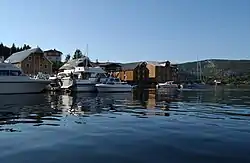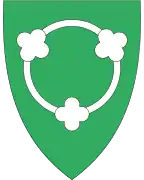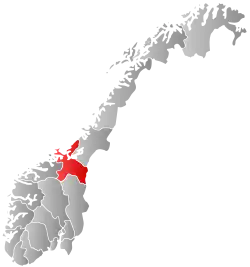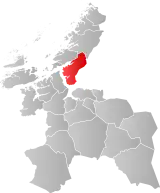Rissa Municipality
Rissa kommune | |
|---|---|
| Rissen herred (historic name) | |
 View of the harbour at Råkvåg | |
 Flag  Coat of arms | |
 Sør-Trøndelag within Norway | |
 Rissa within Sør-Trøndelag | |
| Coordinates: 63°39′20″N 10°02′23″E / 63.65556°N 10.03972°E | |
| Country | Norway |
| County | Sør-Trøndelag |
| District | Fosen |
| Established | 1860 |
| • Preceded by | Stadsbygd Municipality |
| Disestablished | 1 Jan 2018 |
| • Succeeded by | Indre Fosen Municipality |
| Administrative centre | Årnset |
| Area (upon dissolution) | |
| • Total | 621.37 km2 (239.91 sq mi) |
| • Land | 587.85 km2 (226.97 sq mi) |
| • Water | 33.52 km2 (12.94 sq mi) |
| • Rank | #179/426 in Norway |
| Population (2017) | |
| • Total | 6,628 |
| • Rank | #158/426 in Norway |
| • Density | 11.3/km2 (29/sq mi) |
| • Change (10 years) | |
| Demonym | Rissværing[1] |
| Official language | |
| • Norwegian form | Neutral |
| Time zone | UTC+01:00 (CET) |
| • Summer (DST) | UTC+02:00 (CEST) |
| ISO 3166 code | NO-1624[3] |
Rissa is a former municipality in the old Sør-Trøndelag county in Norway in the Fosen region. The municipality existed from 1860 until its dissolution on 1 January 2018 when it became part of the municipality of Indre Fosen in Trøndelag county. The administrative centre of the municipality was the village of Årnset. Other villages in the municipality included Askjem, Hasselvika, Husbysjøen, Rørvika, Råkvåg, and Stadsbygd.
Prior to its dissolution in 2018, the 621-square-kilometre (240 sq mi) municipality was the 179th largest by area out of the then 426 municipalities in Norway. Rissa was the 158th most populous municipality in Norway with a population of 6,628. The municipality's population density was 11.3 inhabitants per square kilometre (29/sq mi) and its population had increased by 4.1% over the last decade.[4]
The municipality was located on the southern end of the Fosen peninsula along the Trondheimsfjord and the Stjørnfjord. The large lake Storvatnet lies on the eastern border with Lensvik. To the north were the municipalities of Åfjord, Bjugn, and Ørland.
The Flakk–Rørvik Ferry crosses the Trondheimsfjord connecting the village of Rørvik with the city of Trondheim.
History
The former municipality of Rissen was established in 1860 when it was separated from the big municipality of Stadsbygd. Initially, Rissen had 3,733 residents. The spelling was later changed to Rissa. On 1 January 1905, the southwestern district of Lensvik (population: 1,019) on the west side of the Trondheimsfjord was separated from Rissa to form a municipality of its own. This left Rissa with 3,394 residents. During the 1960s, there were many municipal mergers across Norway due to the work of the Schei Committee. On 1 January 1964, most of Stadsbygd municipality (except for the Ingdalen area) and the southern part of the municipality of Stjørna were merged with Rissa to form a new, enlarged municipality of Rissa.[5] On 1 January 2018, the neighboring municipalities of Rissa and Leksvik merged to form the new municipality of Indre Fosen which became part of the new Trøndelag county on the same date.[6]
Landslide
In April 1978, a major quick-clay landslide occurred south of Rissa at 63°33′22″N 9°56′41″E / 63.55624°N 9.9446978°E. An area of 330,000 m2 (3,600,000 sq ft) sent 6,000,000 m3 (7,800,000 cu yd) of quick clay slid down into the shores of Botn. The landslip caused a tsunami to strike the north shore at Leira, which destroyed a saw mill and flooded several houses. Out of the 40 people who were in the area at the time of the slide, one person died. A large portion of the slide was recorded on film by two amateur photographers. Almost four years after the event, a new road and stabilisation work in the area had removed most traces of the slide. The area being returned to agricultural use.[7]
Name
The municipality (originally the parish) was historically named "Rissen", or more recently spelled "Rissa" (Old Norse: Rissi). This was probably the old name of the brackish basin of Botn (literally "the bottom" of the fjord). Even though this is a heavily land-locked fjord with a river-like inlet from the Trondheimsfjord (it was probably a shallow bay in prehistoric times). The name is probably derived from the verb rísa which means "raise" or "rise". (The average water level of Botnen is today about 1.7 metres (5 ft 7 in) above mean sea level and the surface water is almost fresh from accumulated internal runoff.)[8] Historically, the name of the municipality was spelled Rissen. On 3 November 1917, a royal resolution changed the spelling of the name of the municipality to Rissa.[9]
Coat of arms
The coat of arms was granted on 23 January 1987 and it was in use until 1 January 2018 when the municipality was dissolved. The official blazon is "Vert, a chaplet of three quatrefoils argent" (Norwegian: I grønt en sølv rosekrans). This means the arms have a green field (background) and the charge is a chaplet (crown) with three quatrefoils. The charge has a tincture of argent which means it is commonly colored white, but if it is made out of metal, then silver is used. The crown design was chosen to symbolize a similar crown of Skule Bårdsson that is depicted on an old tombstone at the Nidaros Cathedral. Bårdsson was the founder of Rein kloster at the Rein estate (which he also owned) in Rissa. The crown is a typical headdress used by the medieval Norwegian dukes. Typically, there are five quatrefoils on a crown like this, but Rissa has only three to symbolize the three municipalities that were merged in 1964 to form Rissa (Rissa, Stadsbygd, and Stjørna). The arms were designed by Oscar Bergsaune. The municipal flag has the same design as the coat of arms.[10][11][12]
Government
While it existed, this municipality was responsible for primary education (through 10th grade), outpatient health services, senior citizen services, unemployment and other social services, zoning, economic development, and municipal roads. During its existence, this municipality was governed by a municipal council of elected representatives, which in turn elected a mayor.[13]
Municipal council
The municipal council (Kommunestyre) of Rissa was made up of 23 representatives that are elected to four year terms. The party breakdown of the final municipal council was as follows:
| Party name (in Norwegian) | Number of representatives | |
|---|---|---|
| Labour Party (Arbeiderpartiet) | 5 | |
| Progress Party (Fremskrittspartiet) | 1 | |
| Green Party (Miljøpartiet De Grønne) | 1 | |
| Conservative Party (Høyre) | 7 | |
| Christian Democratic Party (Kristelig Folkeparti) | 1 | |
| Pensioners' Party (Pensjonistpartiet) | 2 | |
| Centre Party (Senterpartiet) | 4 | |
| Socialist Left Party (Sosialistisk Venstreparti) | 1 | |
| Liberal Party (Venstre) | 1 | |
| Total number of members: | 23 | |
| Party name (in Norwegian) | Number of representatives | |
|---|---|---|
| Labour Party (Arbeiderpartiet) | 5 | |
| Progress Party (Fremskrittspartiet) | 2 | |
| Conservative Party (Høyre) | 8 | |
| Christian Democratic Party (Kristelig Folkeparti) | 1 | |
| Pensioners' Party (Pensjonistpartiet) | 1 | |
| Centre Party (Senterpartiet) | 4 | |
| Socialist Left Party (Sosialistisk Venstreparti) | 1 | |
| Liberal Party (Venstre) | 1 | |
| Total number of members: | 23 | |
| Party name (in Norwegian) | Number of representatives | |
|---|---|---|
| Labour Party (Arbeiderpartiet) | 11 | |
| Progress Party (Fremskrittspartiet) | 2 | |
| Conservative Party (Høyre) | 2 | |
| Christian Democratic Party (Kristelig Folkeparti) | 2 | |
| Pensioners' Party (Pensjonistpartiet) | 1 | |
| Centre Party (Senterpartiet) | 6 | |
| Socialist Left Party (Sosialistisk Venstreparti) | 2 | |
| Liberal Party (Venstre) | 1 | |
| Total number of members: | 27 | |
| Party name (in Norwegian) | Number of representatives | |
|---|---|---|
| Labour Party (Arbeiderpartiet) | 10 | |
| Progress Party (Fremskrittspartiet) | 2 | |
| Conservative Party (Høyre) | 2 | |
| Christian Democratic Party (Kristelig Folkeparti) | 2 | |
| Centre Party (Senterpartiet) | 7 | |
| Socialist Left Party (Sosialistisk Venstreparti) | 3 | |
| Liberal Party (Venstre) | 1 | |
| Total number of members: | 27 | |
| Party name (in Norwegian) | Number of representatives | |
|---|---|---|
| Labour Party (Arbeiderpartiet) | 15 | |
| Progress Party (Fremskrittspartiet) | 1 | |
| Conservative Party (Høyre) | 4 | |
| Christian Democratic Party (Kristelig Folkeparti) | 4 | |
| Centre Party (Senterpartiet) | 9 | |
| Socialist Left Party (Sosialistisk Venstreparti) | 2 | |
| Liberal Party (Venstre) | 2 | |
| Total number of members: | 37 | |
| Party name (in Norwegian) | Number of representatives | |
|---|---|---|
| Labour Party (Arbeiderpartiet) | 12 | |
| Progress Party (Fremskrittspartiet) | 1 | |
| Conservative Party (Høyre) | 3 | |
| Christian Democratic Party (Kristelig Folkeparti) | 4 | |
| Centre Party (Senterpartiet) | 13 | |
| Socialist Left Party (Sosialistisk Venstreparti) | 2 | |
| Liberal Party (Venstre) | 2 | |
| Total number of members: | 37 | |
| Party name (in Norwegian) | Number of representatives | |
|---|---|---|
| Labour Party (Arbeiderpartiet) | 10 | |
| Conservative Party (Høyre) | 4 | |
| Christian Democratic Party (Kristelig Folkeparti) | 4 | |
| Centre Party (Senterpartiet) | 13 | |
| Socialist Left Party (Sosialistisk Venstreparti) | 5 | |
| Liberal Party (Venstre) | 1 | |
| Total number of members: | 37 | |
| Party name (in Norwegian) | Number of representatives | |
|---|---|---|
| Labour Party (Arbeiderpartiet) | 13 | |
| Progress Party (Fremskrittspartiet) | 1 | |
| Conservative Party (Høyre) | 5 | |
| Christian Democratic Party (Kristelig Folkeparti) | 4 | |
| Centre Party (Senterpartiet) | 10 | |
| Socialist Left Party (Sosialistisk Venstreparti) | 2 | |
| Liberal Party (Venstre) | 2 | |
| Total number of members: | 37 | |
| Party name (in Norwegian) | Number of representatives | |
|---|---|---|
| Labour Party (Arbeiderpartiet) | 13 | |
| Conservative Party (Høyre) | 6 | |
| Christian Democratic Party (Kristelig Folkeparti) | 5 | |
| Centre Party (Senterpartiet) | 9 | |
| Socialist Left Party (Sosialistisk Venstreparti) | 1 | |
| Liberal Party (Venstre) | 2 | |
| Local list for South-Stjørna (Bygdeliste for Sør-Stjørna) | 1 | |
| Total number of members: | 37 | |
| Party name (in Norwegian) | Number of representatives | |
|---|---|---|
| Labour Party (Arbeiderpartiet) | 12 | |
| Conservative Party (Høyre) | 6 | |
| Christian Democratic Party (Kristelig Folkeparti) | 5 | |
| Centre Party (Senterpartiet) | 9 | |
| Socialist Left Party (Sosialistisk Venstreparti) | 1 | |
| Liberal Party (Venstre) | 1 | |
| Local list for South-Stjørna (Bygdeliste for Sør-Stjørna) | 3 | |
| Total number of members: | 37 | |
| Party name (in Norwegian) | Number of representatives | |
|---|---|---|
| Labour Party (Arbeiderpartiet) | 10 | |
| Conservative Party (Høyre) | 3 | |
| Christian Democratic Party (Kristelig Folkeparti) | 6 | |
| New People's Party (Nye Folkepartiet) | 1 | |
| Centre Party (Senterpartiet) | 12 | |
| Socialist Left Party (Sosialistisk Venstreparti) | 1 | |
| Liberal Party (Venstre) | 1 | |
| Local list for South-Stjørna (Bygdeliste for Sør-Stjørna) | 3 | |
| Total number of members: | 37 | |
| Party name (in Norwegian) | Number of representatives | |
|---|---|---|
| Labour Party (Arbeiderpartiet) | 13 | |
| Conservative Party (Høyre) | 3 | |
| Christian Democratic Party (Kristelig Folkeparti) | 5 | |
| Centre Party (Senterpartiet) | 11 | |
| Socialist People's Party (Sosialistisk Folkeparti) | 1 | |
| Liberal Party (Venstre) | 4 | |
| Total number of members: | 37 | |
| Party name (in Norwegian) | Number of representatives | |
|---|---|---|
| Labour Party (Arbeiderpartiet) | 12 | |
| Conservative Party (Høyre) | 4 | |
| Christian Democratic Party (Kristelig Folkeparti) | 5 | |
| Centre Party (Senterpartiet) | 9 | |
| Socialist People's Party (Sosialistisk Folkeparti) | 1 | |
| Liberal Party (Venstre) | 6 | |
| Total number of members: | 37 | |
| Party name (in Norwegian) | Number of representatives | |
|---|---|---|
| Labour Party (Arbeiderpartiet) | 14 | |
| Conservative Party (Høyre) | 3 | |
| Christian Democratic Party (Kristelig Folkeparti) | 6 | |
| Centre Party (Senterpartiet) | 10 | |
| Liberal Party (Venstre) | 4 | |
| Total number of members: | 37 | |
| Party name (in Norwegian) | Number of representatives | |
|---|---|---|
| Labour Party (Arbeiderpartiet) | 5 | |
| Conservative Party (Høyre) | 1 | |
| Christian Democratic Party (Kristelig Folkeparti) | 3 | |
| Centre Party (Senterpartiet) | 6 | |
| Liberal Party (Venstre) | 3 | |
| Local List(s) (Lokale lister) | 3 | |
| Total number of members: | 21 | |
| Party name (in Norwegian) | Number of representatives | |
|---|---|---|
| Labour Party (Arbeiderpartiet) | 6 | |
| Conservative Party (Høyre) | 1 | |
| Christian Democratic Party (Kristelig Folkeparti) | 3 | |
| Farmers' Party (Bondepartiet) | 6 | |
| Liberal Party (Venstre) | 3 | |
| Local List(s) (Lokale lister) | 2 | |
| Total number of members: | 21 | |
| Party name (in Norwegian) | Number of representatives | |
|---|---|---|
| Labour Party (Arbeiderpartiet) | 6 | |
| Conservative Party (Høyre) | 2 | |
| Christian Democratic Party (Kristelig Folkeparti) | 2 | |
| Farmers' Party (Bondepartiet) | 5 | |
| Liberal Party (Venstre) | 4 | |
| Local List(s) (Lokale lister) | 1 | |
| Total number of members: | 20 | |
| Party name (in Norwegian) | Number of representatives | |
|---|---|---|
| Labour Party (Arbeiderpartiet) | 5 | |
| Christian Democratic Party (Kristelig Folkeparti) | 3 | |
| Farmers' Party (Bondepartiet) | 4 | |
| Liberal Party (Venstre) | 5 | |
| Local List(s) (Lokale lister) | 3 | |
| Total number of members: | 20 | |
| Party name (in Norwegian) | Number of representatives | |
|---|---|---|
| Labour Party (Arbeiderpartiet) | 5 | |
| Communist Party (Kommunistiske Parti) | 1 | |
| Christian Democratic Party (Kristelig Folkeparti) | 2 | |
| Farmers' Party (Bondepartiet) | 4 | |
| Liberal Party (Venstre) | 5 | |
| Local List(s) (Lokale lister) | 3 | |
| Total number of members: | 20 | |
| Party name (in Norwegian) | Number of representatives | |
|---|---|---|
| Labour Party (Arbeiderpartiet) | 3 | |
| Conservative Party (Høyre) | 1 | |
| Farmers' Party (Bondepartiet) | 6 | |
| Liberal Party (Venstre) | 6 | |
| Local List(s) (Lokale lister) | 4 | |
| Total number of members: | 20 | |
| Note: Due to the German occupation of Norway during World War II, no elections were held for new municipal councils until after the war ended in 1945. | ||
Mayors
- 1860–1863: Henrik Horneman
- 1864–1865: Svend Busch Schmidt
- 1866–1869: Eiler Hagerup Nannestad
- 1870–1873: Svend Busch Schmidt
- 1874–1875: Thomas Horneman
- 1876–1881: Ebbe Bakøen
- 1882–1895: Torger Halten (V)
- 1896–1897: Ole H. Rokseth (H)
- 1898-1898: Torger Halten (V)
- 1899–1902: Fredrik Horneman (H)
- 1903–1904: Ole H. Rokseth (H)
- 1905–1907: Bernt Johannes Ræder (V)
- 1908–1910: Andreas H. Berg (V)
- 1911–1916: Bernt Johannes Ræder (V)
- 1917–1919: Johan A. Dybdahl (V)
- 1920–1922: Elias Aalmo (V)
- 1923–1925: Peter L. Kimo (Bp)
- 1926–1928: Elias Aalmo (V)
- 1929–1931: Peter L. Kimo (Bp)
- 1932–1934: Gustav J. Krognes (Bp)
- 1935–1941: Peter L. Kimo (Bp)
- 1942–1945: Martin Aalmo (NS)
- 1945-1945: Peter L. Kimo (Bp)
- 1946–1947: Martin Skaug (V)
- 1948–1954: Henrik O. Grenne (Bp)
- 1955-1955: Petter Åsarød (V)
- 1956–1959: Marentzius Selven (LL)
- 1960–1967: Andreas Fallin (Sp)
- 1968–1971: Arne Holten (V)
- 1972–1979: Magnar Indseth (Sp)
- 1980–1985: Johan Arnt Sannan (H)
- 1986–1991: Olav Lindgaard (Sp)
- 1992–1995: Ivar Dybdahl (Sp)
- 1995–1998: Astrid Rathe (V)
- 1998–2011: Per Skjærvik (V)
- 2011–2017: Ove Vollan (H)
- 2017-2017: Liv Darell (Sp)
Economy
Fosen Yards
One major employer in Rissa is Fosen Yard AS. Opened in 1972 as Fosen Mekaniske Verksteder, it has built a number of vessels used in Norway and abroad:
- MV Blue Puttees - ferry with Marine Atlantic - ferry with Marine Atlantic
- MV Highlanders - ferry with Marine Atlantic
- MV Leif Ericson - ferry with Marine Atlantic
The company was originally Frengen Slip and Motorverksted (c. 1918) located in Fevåg and moved to Fosen by Jens Petter Bye who acquired Frengen Slip and Motorverksted in 1962.[33]
Churches

The Church of Norway had four parishes (sokn) within the municipality of Rissa. It was part of the Fosen prosti (deanery) in the Diocese of Nidaros.
| Parish (sokn) | Church name | Location of the church | Year built |
|---|---|---|---|
| Hasselvika | Hasselvika Church | Hasselvika | 1951 |
| Rissa | Rissa Church | Leira | 1888 |
| Rein Church | Reinsgrenda | 1932 | |
| Stadsbygd | Stadsbygd Church | Stadsbygd | 1842 |
| Sør-Stjørna | Ramsvik Church | Råkvåg | 1909 |
| Frengen Church | Frengen | 1972 |
See also
References
- ↑ "Navn på steder og personer: Innbyggjarnamn" (in Norwegian). Språkrådet.
- ↑ "Forskrift om målvedtak i kommunar og fylkeskommunar" (in Norwegian). Lovdata.no.
- ↑ Bolstad, Erik; Thorsnæs, Geir, eds. (26 January 2023). "Kommunenummer". Store norske leksikon (in Norwegian). Kunnskapsforlaget.
- ↑ Statistisk sentralbyrå (2017). "Table: 06913: Population 1 January and population changes during the calendar year (M)" (in Norwegian). Retrieved 7 October 2017.
- ↑ Jukvam, Dag (1999). Historisk oversikt over endringer i kommune- og fylkesinndelingen (PDF) (in Norwegian). Statistisk sentralbyrå. ISBN 9788253746845.
- ↑ "Om Indre Fosen" (in Norwegian). Retrieved 7 October 2017.
- ↑ NGI presents the Rissa Landslide: quick clay in Norway (Motion picture). Oslo, norway: Norwegian Geotechnical Institute. 1981. Retrieved 31 December 2020.
- ↑ Rygh, Oluf (1901). Norske gaardnavne: Søndre Trondhjems amt (in Norwegian) (14 ed.). Kristiania, Norge: W. C. Fabritius & sønners bogtrikkeri. p. 101.
- ↑ "Norsk Lovtidende. 2den Afdeling. 1917. Samling af Love, Resolutioner m.m". Norsk Lovtidend (in Norwegian). Kristiania, Norge: Grøndahl og Søns Boktrykkeri: 1057–1065. 1917.
- ↑ "Civic heraldry of Norway - Norske Kommunevåpen". Heraldry of the World. 24 July 2022. Retrieved 20 February 2023.
- ↑ "Rissa, South Trøndelag (Norway)". Flags of the World. Retrieved 20 February 2023.
- ↑ "Godkjenning av våpen og flagg". Lovdata.no (in Norwegian). Norges kommunal- og arbeidsdepartementet. 23 January 1987. Retrieved 20 February 2023.
- ↑ Hansen, Tore; Vabo, Signy Irene, eds. (20 September 2022). "kommunestyre". Store norske leksikon (in Norwegian). Kunnskapsforlaget. Retrieved 1 January 2023.
- 1 2 3 4 "Table: 04813: Members of the local councils, by party/electoral list at the Municipal Council election (M)" (in Norwegian). Statistics Norway.
- ↑ "Tall for Norge: Kommunestyrevalg 2011 – Sør-Trøndelag". Valg Direktoratet. Retrieved 19 April 2020.
- ↑ "Kommunestyrevalget 1995" (PDF) (in Norwegian). Oslo-Kongsvinger: Statistisk sentralbyrå. 1996. Retrieved 14 April 2020.
- ↑ "Kommunestyrevalget 1991" (PDF) (in Norwegian). Oslo-Kongsvinger: Statistisk sentralbyrå. 1993. Retrieved 14 April 2020.
- ↑ "Kommunestyrevalget 1987" (PDF) (in Norwegian). Oslo-Kongsvinger: Statistisk sentralbyrå. 1988. Retrieved 14 April 2020.
- ↑ "Kommunestyrevalget 1983" (PDF) (in Norwegian). Oslo-Kongsvinger: Statistisk sentralbyrå. 1984. Retrieved 14 April 2020.
- ↑ "Kommunestyrevalget 1979" (PDF) (in Norwegian). Oslo: Statistisk sentralbyrå. 1979. Retrieved 14 April 2020.
- ↑ "Kommunevalgene 1975" (PDF) (in Norwegian). Oslo: Statistisk sentralbyrå. 1977. Retrieved 14 April 2020.
- ↑ "Kommunevalgene 1972" (PDF) (in Norwegian). Oslo: Statistisk sentralbyrå. 1973. Retrieved 14 April 2020.
- ↑ "Kommunevalgene 1967" (PDF) (in Norwegian). Oslo: Statistisk sentralbyrå. 1967. Retrieved 14 April 2020.
- ↑ "Kommunevalgene 1963" (PDF) (in Norwegian). Oslo: Statistisk sentralbyrå. 1964. Retrieved 14 April 2020.
- ↑ "Kommunevalgene og Ordførervalgene 1959" (PDF) (in Norwegian). Oslo: Statistisk sentralbyrå. 1960. Retrieved 14 April 2020.
- ↑ "Kommunevalgene og Ordførervalgene 1955" (PDF) (in Norwegian). Oslo: Statistisk sentralbyrå. 1957. Retrieved 14 April 2020.
- ↑ "Kommunevalgene og Ordførervalgene 1951" (PDF) (in Norwegian). Oslo: Statistisk sentralbyrå. 1952. Retrieved 14 April 2020.
- ↑ "Kommunevalgene og Ordførervalgene 1947" (PDF) (in Norwegian). Oslo: Statistisk sentralbyrå. 1948. Retrieved 14 April 2020.
- ↑ "Kommunevalgene og Ordførervalgene 1945" (PDF) (in Norwegian). Oslo: Statistisk sentralbyrå. 1947. Retrieved 14 April 2020.
- ↑ "Kommunevalgene og Ordførervalgene 1937" (PDF) (in Norwegian). Oslo: Statistisk sentralbyrå. 1938. Retrieved 14 April 2020.
- ↑ Sæther, Stein Arne, ed. (1993). Fosen. Natur, kultur og mennesker (in Norwegian). Trondheim: Adresseavisens Forlag. pp. 215–216.
- ↑ "Tidligere ordførere Rissa" (in Norwegian). Rissa kommune. Archived from the original on 6 June 2017. Retrieved 6 June 2016.
- ↑ "History – Fosen Yard AS".
External links
- The Quick Clay Landslide at Rissa (Youtube video)
 Trøndelag travel guide from Wikivoyage
Trøndelag travel guide from Wikivoyage
